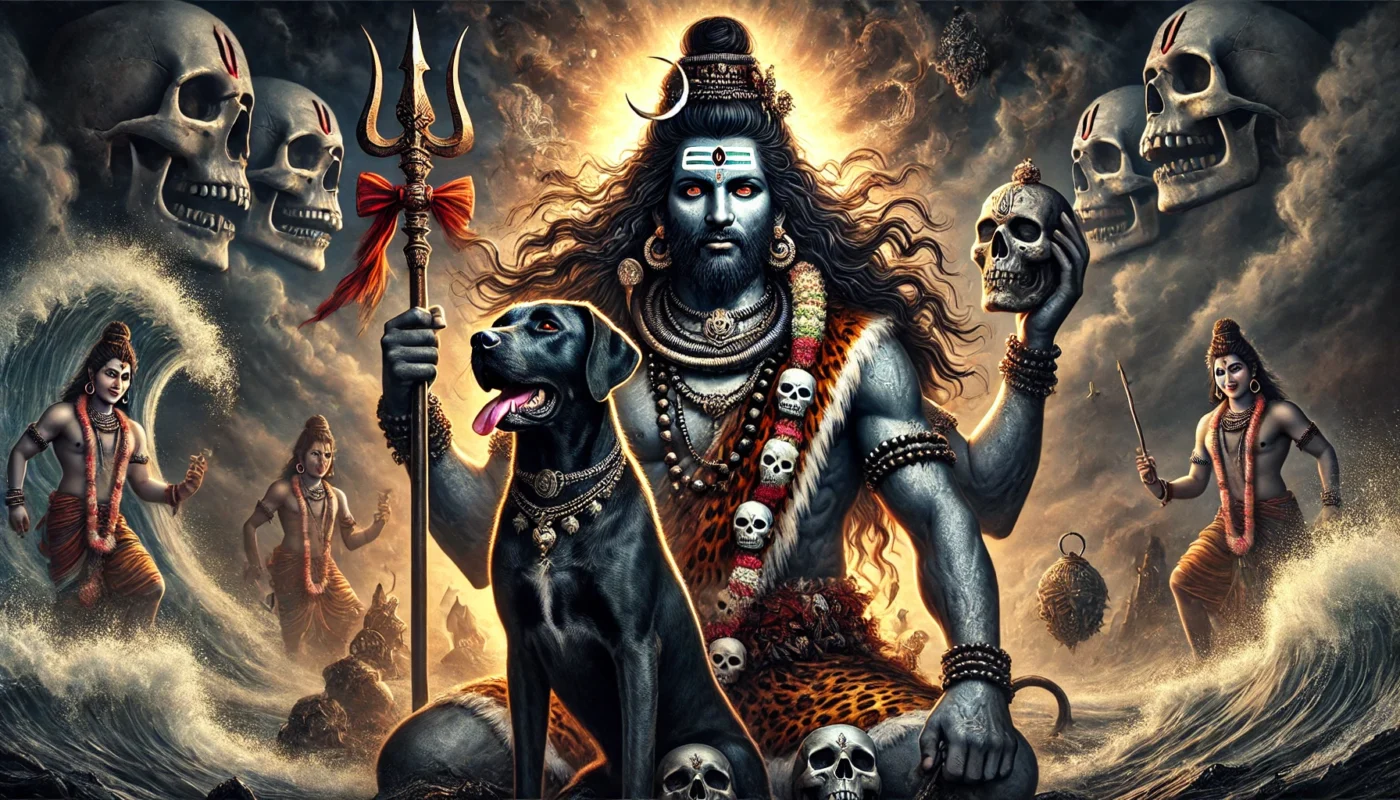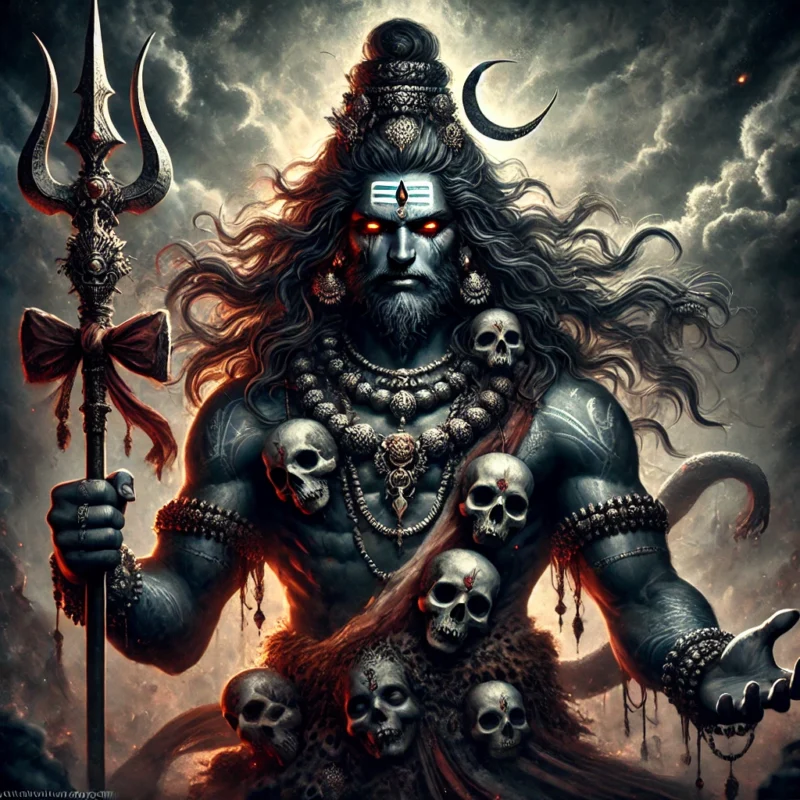While there are many forms of Lord Shiva, his one incarnation is considered to be his very intense form, and that form is Lord Shiva’s Bhairav form. Bhairav is known as the destroyer of the universe. In Hinduism, Bhairav is generally worshiped as a tantric deity. In astrology, Lord Bhairava is regarded as the lord of the planet Rahu and therefore people who wish to seek maximum benefits from Rahu are advised to worship Lord Bhairava.
This article will help you learn more about Lord Shiva’s Bhairav form.
Meaning of Bhairav
In Hinduism, Bhairav is also known as Kal Bhairav or often Dandapani, which means “one who holds a staff to punish sinners.” He is also referred to as Swaswa, which means “one whose vehicle is a dog.” Bhairava is worshiped not only throughout India, but he is well worshiped in Nepal, Sri Lanka, and Tibetan Buddhism as well.
The term Bhairav is derived from the Sanskrit word “Bhiru,” which means frightening. It is believed that the appearance of Lord Bhairava is very terrifying or frightening. Lord Bhairava has four arms, and he possesses a damaru (drum), noose, trident, and a skull. In some forms, Lord Bhairava is also represented as having more than four arms. His weapons, his dog, and his prominent teeth make him appear fearsome. It is believed that this form of Lord Shiva is beyond and above any fear or terror. It is also believed that Bhairava destroys fear and protects his devotees from terrifying enemies such as greed, lust, and anger.
According to one another Interpretation, the word Bhairavacan be broken down as follows:
- Bh means creation
- Ra means preservation
- Va means destruction
Thus, Bhairava is that one form of Lord Shiva that can create, sustain, and destroy. Creation, sustainment and destruction also represents the three stages of life.
If you wish to know more about the various incarnations of Lord Shiva, read our article here.
The Origin of Kal Bhairav

The origin of Bhairava can be understood from a conversation between Lord Vishnu and Brahma, as described in the “Shiva Mahapurana.” According to this story, once Lord Vishnu asked Brahma who is the supreme being in the universe to which Lord Brahma declared himself as that supreme being. In response, Lord Vishnu mocked Brahma’s haste and arrogance. After a debate, they decided to seek answers from the four Vedas.
The Rigveda declared Lord Shiva as the omnipotent deity who governs all living beings. The Yajurveda responded that the deity we worship through various rituals is none other than Lord Shiva. The Samaveda stated that the revered one, worshiped by various yogis and who governs the entire world, is Lord Shiva. Finally, the Atharvaveda stated that the deity who can remove all human concerns and who can be seen through devotion is indeed Shankar i.e., Lord Shiva. However, both Brahma and Vishnu laughed in disbelief.
Subsequently, Lord Shiva manifested himself as a powerful pillar of divine light and appeared before the two deities and asked them to find the beginning and the end of the divine pillar. Brahma not only lied that he had found the beginning of the divine light but also stared at Lord Shiva angrily with his fifth head. Lord Shiva got infuriated upon this and created another form of himself and declared that he would be the king of time and would be known as Kal Bhairav. Hearing this Brahma’s fifth head laughed loudly and, in anger, Kal Bhairav severed Brahma’s fifth head.
However, Brahma’s severed head clung to Bhairav’s hand due to the sin of Brahma-hatya (killing of Brahman). Lord Shiva instructed Bhairav to travel to various pilgrimage sites to atone for the sin of Brahma-hatya. Kal Bhairav, holding Brahma’s head, bathed at various sacred sites, worshiped various deities, but still did not find relief from the sin. Finally, Kal Bhairav reached Moksha Puri (Kashi). As soon as Kal Bhairav entered Kashi, Brahma’s skull fell from his hand, and the sin of Brahma-hatya was eradicated.
The place where Brahma’s skull fell from Bhairav’s hand was named Kapal Mochan, and a pilgrimage site was established there, later known as Kapal Mochan Tirth. Thereafter, Kal Bhairav settled permanently in Varanasi and began providing refuge to all his devotees.
The Eight Forms of Kal Bhairav
Local legends also believe that Kal Bhairav has eight forms, known as Ashtang Bhairav. These eight Bhairavas are considered as the controllers of the eight directions of the universe. It is believed that Ashtang Bhairav blesses their devotees with Ashta Lakshmi, representing eight types of wealth. Ashtang Bhairav appears in different forms and possesses different weapons and vehicles. There are specific mantras to please each Ashtang Bhairav. Each Ashtang Bhairav is also presided over by seven sub-Bhairavs.
All these various forms of Bhairav have originated from Lord Shiva, known as Maha Bhairav. Maha Bhairav is adorned with twisted serpents, represented as ear ornaments, anklets, and bracelets. He is depicted wearing a tiger skin and human bones.
The names of the Ashtang Bhairavs are as follows;
- Chand Bhairav
- Ruru Bhairav
- Asitang Bhairav
- Kapal Bhairav
- Krodh Bhairav
- Sanhar Bhairav
- Bhishan Bhairav
- Unmatt Bhairav
Kal Bhairav Mantras:
To practice devotion to Kal Bhairav and receive his blessings, the following mantras can be chanted daily. These mantras have the power to eliminate all problems and bring happiness to you and your family.
The mantras are:
- Om Kal Bhairavaya Namah
- Om Bhram Kalabhairavaya Phat
- Om Kreem Kreem Kalabhairavaya Phat
- Om Shri Bhairavaya Namah
- Om Ham Sham Nam Gam Kam Sam Kham Mahakal Bhairavaya Namah
- Om Hreem Batukaya Apaduddharanaya Kuru Kuru Batukaya Hreem
- Om Bhayaharanam Cha Bhairavah
- Om Brahma Kalabhairavaya Phat
- Om Kar Kalit Kapal Kundali Dandapani Tarun Timir Vyal Yajnopaveeti Karttu Samaya Saparaya Vighnnavichheda Hetave Jayati Batuka Nath Siddhi Sadhakanam Om Shri Bam Batuk Bhairavaya Namah








3 Comments
Comments are closed.